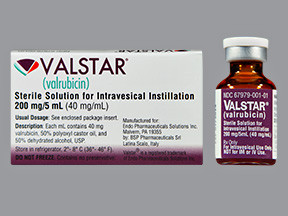VALRUBICIN - INTRAVESICAL
PHONETIC PRONUNCIATION: (val-REWB-eh-sin)
COMMON BRAND NAME(S): Valstar
GENERIC NAME(S): valrubicin
Uses
USES: Valrubicin is used to treat bladder cancer. The usual treatment for bladder cancer is surgery. However, if you and your doctor decide that the risk of surgery is greater than its benefit or that surgery may be delayed, this medication may be used as part of your treatment. This medication belongs to a class of drugs known as anthracyclines and works by slowing or stopping the growth of cancer cells. This medication may not cure your cancer. Delaying surgery could lead to a more serious illness (metastatic cancer). Discuss the risks and benefits of this medication with your doctor.
How to use VALRUBICIN - INTRAVESICAL
HOW TO USE: This medication is given by placement into the bladder as directed by your doctor. Do not give by injection into a vein or muscle or under the skin. After this medication is placed through a tube (catheter), it is usually left in the bladder for 2 hours, then released by urinating. This drug is usually used once weekly for 6 weeks or as directed by your doctor. Drink plenty of fluids after each treatment with this medication unless otherwise directed by your doctor. Doing so helps clear it from your body and decrease side effects.
Side Effects
Precautions
Interactions
Overdose
Images
Reviews
Faq for VALRUBICIN - INTRAVESICAL
Valrubicin intravesical is used to treat bladder cancer that has not spread to the muscle wall of the bladder.
Valrubicin is a chemotherapy drug that works by interfering with the DNA replication in cancer cells, preventing their growth and causing them to die.
Valrubicin is administered directly into the bladder through a catheter, usually once a week for 6 weeks. The treatment is done in a healthcare setting by a healthcare professional.
Common side effects may include bladder irritation, urinary frequency, dysuria (painful urination), hematuria (blood in the urine), and urinary tract infection. Other less common but serious side effects may occur and should be immediately reported to a doctor.
Valrubicin intravesical is not recommended for use in pregnant women as it may harm the unborn baby. It is also not known if Valrubicin passes into breast milk, so breastfeeding is not recommended during treatment.
The treatment usually lasts for 6 weeks, with one intravesical instillation per week. However, the treatment duration may vary depending on the individual's response and the recommendation of the healthcare provider.
It is essential to follow the healthcare provider's instructions regarding proper catheter insertion and management to prevent infections. Valrubicin may temporarily turn urine red or orange, which is normal and not a cause for concern.
Valrubicin intravesical has shown efficacy in treating non-muscle invasive bladder cancer. It has been found to reduce the risk of cancer recurrence and progression.
Valrubicin can be used as a stand-alone treatment or in combination with other therapies, such as surgery or immunotherapy. The choice of therapy depends on the individual's specific condition and the recommendation of the healthcare provider.
Disclaimer
IMPORTANT: HOW TO USE THIS INFORMATION: This is a summary and does NOT have all possible information about this product. This information does not assure that this product is safe, effective, or appropriate for you. This information is not individual medical advice and does not substitute for the advice of your health care professional. Always ask your health care professional for complete information about this product and your specific health needs.

No Reviews Yet